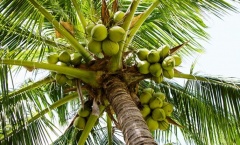Difference between revisions of "Coconuts"
From Cargo Handbook - the world's largest cargo transport guidelines website
| Line 4: | Line 4: | ||
| stowage factor = - | | stowage factor = - | ||
| humidity and moisture = <ul><li>Water content: 42-48%</li><li>Oil content: 30-40% | | humidity and moisture = <ul><li>Water content: 42-48%</li><li>Oil content: 30-40% | ||
| − | | ventilation = | + | | ventilation = - |
| − | | risk factors = | + | | risk factors = - |
}} | }} | ||
| + | ==Description== | ||
| + | ===Postharvest cooling, handling and storage of (fresh) Coconuts=== | ||
| + | {| | ||
| + | |- | ||
| + | |style="width:105px;"|<b>Freshness facts</b> | ||
| + | |style="width:85px;"| | ||
| + | |- | ||
| + | | Loading temperature | ||
| + | | 23 dC | ||
| + | |- | ||
| + | | Travel temperature | ||
| + | | 15 dC | ||
| + | |- | ||
| + | | Solidification temperature | ||
| + | | -15 dC | ||
| + | |- | ||
| + | | Pumping temperature | ||
| + | | approx 23 dC | ||
| + | |} | ||
Revision as of 11:55, 13 February 2013
| Infobox on Coconuts | |
|---|---|
| Example of Coconuts |  |
| Facts | |
| Origin | - |
| Stowage factor (in m3/t) | - |
| Humidity / moisture |
|
| Ventilation | - |
| Risk factors | - |
Coconuts
Contents
Description
Postharvest cooling, handling and storage of (fresh) Coconuts
| Freshness facts | |
| Loading temperature | 23 dC |
| Travel temperature | 15 dC |
| Solidification temperature | -15 dC |
| Pumping temperature | approx 23 dC |











